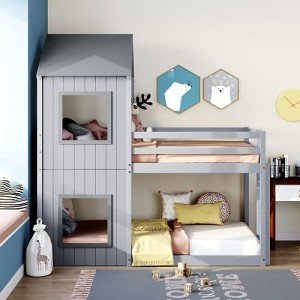20 Things That Only The Most Devoted Bunk Beds Sale Fans Understand

Bunk Beds Sale: A Comprehensive Guide to Choosing the Right Bunk Bed for Your Home
Bunk beds have actually long been a staple in kids's bed rooms, providing a combination of space-saving efficiency and fun. Whether accommodating brother or sisters, buddies on slumber parties, or simply maximizing a playroom, bunk beds have actually become an essential aspect in modern-day family homes. As sales on bunk beds increase, it ends up being significantly crucial for customers to make educated decisions when purchasing one. This article will cover the basics of buying a bunk bed, from types to safety functions, in addition to pointers for maintaining the stability of your investment.
Kinds Of Bunk Beds
When considering a bunk bed sale, it's essential to understand the various styles offered on the market. Below are the most typical types:
- Traditional Bunk Beds: These consist of 2 beds stacked one above the other, sharing a single frame. They are frequently the most economical alternative.
- L-Shaped Bunk Beds: This style includes one bed positioned vertically and another horizontally. This plan develops extra space below the upper bed, which can be utilized for storage or a backyard.
- Lofted Beds: Similar to traditional bunk beds but with no lower bed. Instead, the space below can be made use of for a desk, play area, or additional storage.
- Triple Bunk Beds: For families with a bigger variety of kids or regular slumber parties, triple bunk beds offer 3 sleeping locations in a space-efficient style.
- Futon Bunk Beds: These styles combine bunk beds and futon sofas. The bottom area transforms into a separate seating location, improving performance.
- Convertible Bunk Beds: These beds can be separated into two specific beds, making them versatile as kids's needs alter with time.
Table 1: Comparison of Bunk Bed Types
| Type | Description | Space Efficiency | Extra Features |
|---|---|---|---|
| Standard Bunk Bed | 2 beds stacked vertically | High | Most basic design |
| L-Shaped Bunk Bed | One vertical and one horizontal bed | Moderate | Play or storage space |
| Lofted Bed | Elevated bed with open space listed below | High | Work/play area |
| Triple Bunk Bed | 3 stacked beds | Extremely High | Accommodates more users |
| Futon Bunk Bed | Bunk bed with a convertible futon | High | Multi-functional |
| Convertible Bunk Bed | Can be divided into two separate beds | Moderate | Flexibility & & durability |
Security Features to Consider
Security is vital when purchasing a bunk bed. Below are crucial safety features to look for:
- Guardrails: Adequate guardrails must exist on both sides of the upper bunk to prevent falls. They should be at least 5 inches higher than the mattress.
- Ladder Design: Look for tough, large ladders with slip-resistant rungs. Ensure that the angle is not too steep for simple gain access to.
- Stability: Ensure the bed is built with strong products, such as strong wood or heavy-duty metal. The bed should not wobble when in use.
- Weight Limit: Check the weight capability of the bunk bed to ensure it can accommodate the intended users securely.
- Product Safety: If possible, choose beds made from non-toxic products or those meeting safety standards for children's furniture.
Table 2: Essential Safety Features
| Function | Description | Value |
|---|---|---|
| Guardrails | Sides of upper bed to avoid falls | Important for kid safety |
| Ladder Design | Strong, slip-resistant rungs | Aids safe and simple gain access to |
| Stability | Develop quality to prevent wobbling | Makes sure security and longevity |
| Weight Limit | Optimum weight capability | Prevents accidents |
| Material Safety | Non-toxic, safe materials | Safeguards kids's health |
Maintenance Tips for Bunk Beds
To extend the life of your bunk bed and ensure ongoing safety, consider the following upkeep tips:
- Regular Inspections: Periodically check the structure for loose screws, bolts, or any signs of wear. Tighten michaelhess.top as needed.
- Clean Periodically: Dust and clean the surface areas routinely. Use proper cleaners that won't harm the finish.
- Examine Weight Limits: Be mindful of weight limits, particularly with older kids or adults who might want to use the upper bunk.
- Avoid Climbing on Guardrails: Educate kids not to utilize guardrails for climbing up or playing to lower the risk of accidents.
Frequently Asked Questions (FAQs)
Q1: What is the age limitation for children to securely use bunk beds?A: While it differs by the producer, numerous recommend that kids under 6 must not oversleep the upper bunk due to security issues.
Q2: How can parents discourage risky climbing?A: Setting clear guidelines about bunk bed use and monitoring kids can help. Furthermore, utilizing a bed tent can dissuade climbing while creating an enjoyable sleep environment.
Q3: What should I think about when decorating a room with bunk beds?A: Ensure there suffices space around the bunk bed for safe motion, and utilize the decoration to create individualized areas for each child.
Q4: Is a lofted bed suitable for older kids?A: Yes, lofted beds can be appropriate for older children as long as they meet safety requirements and the kid is responsible enough to utilize them securely.
Bunk beds serve a functional function while adding a component of enjoyable to a child's bedroom. As sales of bunk beds continue to rise, mindful consideration of types, security functions, and upkeep practices is important for parents and caregivers. By understanding these essential aspects, families can discover the best bunk bed for their home, guaranteeing both practicality and safety for many years to come. Whether it's for brother or sisters sharing a room or developing a relaxing sleepover space, a well-chosen bunk bed can supply pleasure and usefulness, making it a worthy investment.

